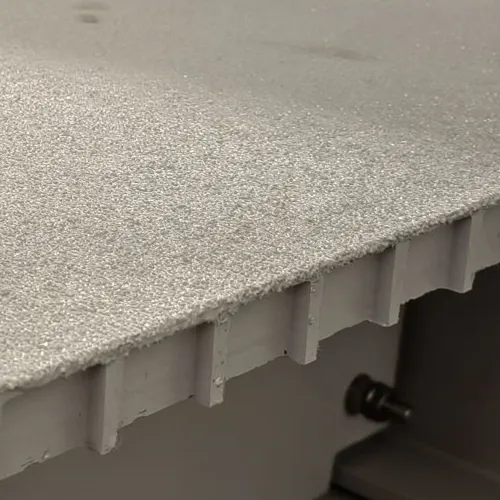loading...
- No. 9, Xingyuan South Street, Dongwaihuan Road, Zaoqiang County, Hengshui, Hebei, China
- admin@zjcomposites.com
- +86 15097380338
- Welcome to visit our website!
Innovative Fiber Reinforced Polymer Grating Walkway Solutions for Enhanced Safety and Durability
The Benefits and Applications of FRP Grating Walkways
In the construction industry, the need for durable and lightweight materials has become increasingly important. One innovative solution that has gained popularity is Fiber Reinforced Polymer (FRP) grating walkways. These walkways, made from a mixture of fiberglass and resin, offer numerous advantages and find applications in various fields, including industrial, commercial, and recreational settings. This article explores the benefits and applications of FRP grating walkways, illustrating why they have become a preferred choice in many projects.
Lightweight and Strong
One of the most significant advantages of FRP grating is its lightweight nature. Compared to traditional materials such as steel or concrete, FRP grating is remarkably lighter while maintaining a high strength-to-weight ratio. This lightweight characteristic facilitates easier handling and installation, which can reduce labor costs and construction time. Despite its lightness, FRP grating provides excellent strength, making it capable of withstanding heavy loads and stress, which is essential for walkways, platforms, and other structures.
Corrosion Resistance
Corrosion is a common issue in many environments, particularly in industries like oil and gas, chemical processing, and marine applications. Traditional materials like steel can quickly deteriorate when exposed to harsh chemicals, moisture, and salt, leading to costly repairs or replacements. FRP grating, on the other hand, boasts exceptional corrosion resistance, making it an ideal choice for environments where corrosive substances are present. By using FRP walkways, businesses can extend the lifespan of their structures and reduce maintenance costs over time.
Slip Resistance
Safety is a paramount concern in any setting, especially in high-traffic areas. FRP grating walkways are designed with slip-resistant surfaces, which significantly enhance user safety. The textured surfaces of FRP grating provide better traction, reducing the risk of slips and falls, even in wet or oily conditions. This feature makes FRP walkways particularly suitable for industrial applications where spills are common, ensuring that employees can navigate safely.
Environmental Sustainability
frp grating walkway

As sustainability becomes a key focus in modern construction, FRP materials stand out due to their lower environmental impact compared to traditional materials. The production processes of FRP grating often require fewer natural resources and generate less waste. Moreover, FRP walkways can be manufactured using recycled materials, contributing to a circular economy. When the time comes to replace or decommission FRP structures, they can be recycled, further reducing landfill contributions and environmental harm.
Versatility in Design
FRP grating walkways offer designers and engineers a high degree of versatility. They can be produced in various sizes, shapes, and colors, allowing for customization to meet specific project requirements. Whether for pedestrian walkways, industrial catwalks, or platforms in recreational areas, FRP grating can be tailored to fit any design mandate. This versatility is crucial in modern construction, where aesthetics often play an essential role alongside functionality.
Ease of Maintenance
Another notable advantage of FRP grating walkways is their low maintenance requirements. Unlike traditional materials that may require frequent painting, sealing, or other upkeep, FRP grating is relatively maintenance-free. Its resistance to rot, rust, and corrosion means that routine inspections often suffice. This factor not only reduces the long-term costs associated with remedial tasks but also allows property owners to allocate their resources more efficiently.
Applications Across Industries
The applications of FRP grating walkways are vast and varied. In industrial settings, they are commonly used for platforms in chemical processing plants, wastewater treatment facilities, and oil refineries. In commercial environments, FRP walkways can be found in shopping malls, airports, and recreational parks, enhancing safety and accessibility. Additionally, many municipalities are installing FRP grating in public spaces, such as bridges and boardwalks, since they combine durability with aesthetic appeal.
Conclusion
In summary, FRP grating walkways are a modern solution that brings together strength, safety, and sustainability. Their lightweight nature, remarkable corrosion resistance, and slip-resistant surfaces make them ideal for a range of applications, contributing to enhanced safety and reduced maintenance costs. As industries continue to seek innovative materials and solutions, the demand for FRP grating walkways is likely to grow, making them a staple in the landscape of modern construction.
-
GRP Structures: The Future of Lightweight, High-Performance EngineeringNewsJun.20,2025
-
FRP Water Tank: High-Performance Storage for Corrosive and Clean Water SystemsNewsJun.20,2025
-
FRP Square Tube: The New Industry Standard for Chemical and Structural ApplicationsNewsJun.20,2025
-
FRP Pultruded Profiles: The Ultimate Choice for Lightweight Structural StrengthNewsJun.20,2025
-
FRP Handrails: The Safer, Smarter, and Stronger Choice for Modern InfrastructureNewsJun.20,2025
-
FRP Grating: The Smart Solution for Durable, Lightweight Industrial FlooringNewsJun.20,2025
-
Why Choose a Galvanized Water Tank for Your Storage NeedsNewsMay.21,2025
